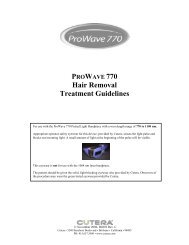Solar Lentigines Treatment Guidelines - Medsystems
Solar Lentigines Treatment Guidelines - Medsystems
Solar Lentigines Treatment Guidelines - Medsystems
Create successful ePaper yourself
Turn your PDF publications into a flip-book with our unique Google optimized e-Paper software.
• The fluence setting should be selected to provide the desired treatment without effecting the pigmentation<br />
of background skin.<br />
• Use lower fluences for darker targets, both pigmented and vascular, or over bony areas.<br />
• The potential for overtreatment is greatest with skin type IV and patients with the pigmentary effects of<br />
long-term tanning (actinic bronzing). Begin with low settings for the initial test treatment.<br />
• Fluence settings should not be based on settings used with other pulsed light devices.<br />
RECOMMENDED TECHNIQUE:<br />
• When telangiectasia are present, with or without solar lentigines, apply a thin layer of clear (no color)<br />
ultrasound gel and use standard cooling (5° or 10° C).<br />
• When only solar lentigines are present, use Sun Mode and no gel. This allows use of reduced fluences.<br />
• Place the entire light-emitting window in contact with the area to be treated.<br />
• Activate the light pulse.<br />
• Place the window over the next treatment area and treat in the same manner.<br />
• If treating an area with closely spaced lentigines, place treatment pulses adjacent to one another so that<br />
there is no more than 1 mm overlap between pulses.<br />
• The desired response for lentigines is some darkening of the treated lentigines, and possibly mild erythema.<br />
If a large portion of the treated area darkens or develops significant erythema, the fluence should be<br />
reduced. This effect is often delayed.<br />
• The desired response for telangiectasia treatments immediately is constriction or darkening of the vessel. If<br />
results are not seen at the lower settings, the fluence may be gradually increased as new areas are treated<br />
while watching for the desired endpoint as well as epidermal damage. <strong>Treatment</strong> may also affect pigment,<br />
which may have a delayed reaction.<br />
• Always observe the epidermis during the treatment, watching for signs of damage (epidermal separation or<br />
gray coloration). If damage is seen, stop the treatment, cool the skin, and reduce the fluence before<br />
continuing.<br />
• Do not “double pulse” or retreat an area within a single visit.<br />
• Ensure that the window remains clean during the treatment. This is especially important when treating over<br />
areas with hair.<br />
POST-OPERATIVE CARE:<br />
• Ice, chilled gel, or hydro-gel pads may be applied post-treatment as needed for patient comfort. The<br />
treatment window can also be used as an effective post-cooling device.<br />
• Treated lentigines usually darken after treatment, and crusting begins to form within a few days. This<br />
crusting usually resolves in 1 to 3 weeks. It should be allowed to naturally flake off for best results.<br />
• The recommended treatment interval is 4 weeks or longer, depending on the rate of clearance.<br />
• Localized erythema may also be present and typically resolves within 24 to 48 hours. If prolonged<br />
erythema occurs, future treatments should be performed at a lower fluence.<br />
• If a wound develops an antibiotic ointment may be recommended.<br />
• Patients should avoid artificial tanning, or sun exposure without sun protection, between treatments.<br />
© November 2006, D0481 Rev. C LimeLight <strong>Treatment</strong> <strong>Guidelines</strong><br />
Page 4 of 4



